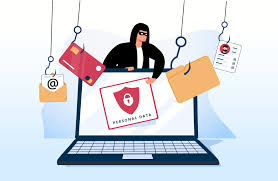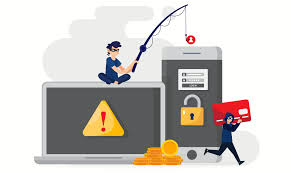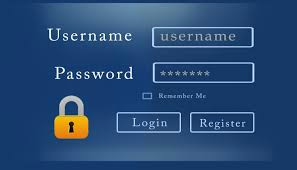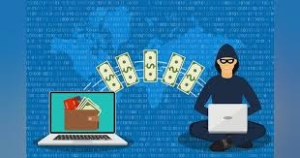When someone reaches out to you asking for confirmation of your personal information or presents an offer for a loan, it’s essential to approach the situation with caution, as it could very well be a fraudulent scheme. Scammers are adept at exploiting personal data to illegally access your finances, potentially leading to significant financial losses and debts accrued in your name.

If you suspect that an investment opportunity presented to you is questionable, it’s prudent to report it. By doing so, you not only protect yourself but also contribute to a broader effort to alert others about potential scams.
Understanding the mechanics behind banking and credit scams can help you stay vigilant. These deceitful tactics can manifest in various forms, whether through online platforms, social media channels, phone calls, text messages, or emails. Familiarising yourself with the indicators of a scam empowers you to recognise suspicious activities and safeguard your personal information.
One prevalent form of deception is phishing. This occurs when a scammer attempts to acquire your sensitive information with the intention of infiltrating your online accounts. The process usually unfolds in a few manipulative stages.
Initially, the scammer will assume a false identity, posing as a reputable entity such as your bank, internet service  provider, government agency, business, law enforcement personnel, or even acquaintances from your circle. They may present seemingly legitimate information, including personal details, designed to lend credibility to their act and earn your trust.
provider, government agency, business, law enforcement personnel, or even acquaintances from your circle. They may present seemingly legitimate information, including personal details, designed to lend credibility to their act and earn your trust.
Once they’ve established this facade, they’ll typically claim that there’s an urgent issue that requires your immediate attention. This could range from a purported problem with your computer or online banking account to claims of overpayments or suspicious activity detected in your account.
In their efforts to gain control over your sensitive information, scammers might request that you:
– Confirm or update your login credentials, passwords, or other personal details.
– Validate your banking information under the pretence of issuing a ‘refund.’
– Provide banking verification codes.
– Click on the links they send you.
– Download software they claim is necessary for resolving a nonexistent issue.
– Grant them remote access to your computer under the guise of ‘fixing’ a problem.
– Make an unexpected payment.
As you navigate communications that could be scams, there are several red flags to watch for. If the email address does not align with the official company name or originates from a free email service such as Hotmail, Gmail, or Outlook, this should raise suspicion. Additionally, if you notice any spelling errors or if the message content appears nonsensical, these are strong indicators of potential fraud. Finally, be wary if you’re urged to take immediate action—whether that involves clicking on a link, providing a code, or downloading software—these are classic tactics employed by scammers to manipulate unsuspecting individuals into compromising their personal information.

By remaining vigilant and informed about these tactics, you can better protect yourself from falling victim to such scams.
In the realm of banking, it’s crucial to be vigilant. While your bank may reach out to you if they detect any questionable transactions, rest assured that they will never solicit sensitive information from you. This means they will never ask for your online banking passwords or verification codes, nor will they request that you download any software or transfer funds. Additionally, they would never prompt you to log into your online banking account via a link sent through text messages or emails.
Now, let’s talk about credit card scams. It’s alarming to realise that scammers don’t actually need to possess your physical credit card to exploit it; all they require are the details associated with it. These details could fall into the wrong hands if you enter them on an unsecured website or while connected to public Wi-Fi networks. Furthermore, if your card happens to be lost or stolen, the risk increases significantly.
There are telltale signs that indicate you might be dealing with a credit card scam. For instance, if you notice unusual transactions on your credit card statement, that should raise a red flag. Be wary if someone reaches out to you via phone, text, or email, claiming to be a friend or relative in urgent need of a credit card payment. Such individuals might also attempt to convince you to “verify” your card information. It is prudent to review your credit card statements regularly—particularly if you have lost your card or believe it has been stolen. If anything looks unfamiliar, contact your bank immediately.

Loan scams are another area where caution is necessary. Scammers often send unsolicited emails or texts informing you that you’ve been approved for a loan you never applied for, or they may reach out after you’ve filled out an inquiry form online.
How can you identify a loan scam? If the loan offer seems too good to be true—like an unbelievably low interest rate—that’s a warning sign. Similarly, if there’s no credit check involved or you’re promised guaranteed approval, exercise scepticism. Be particularly cautious if they ask for an upfront deposit or your banking details and if they pressure you to act quickly because the offer is about to expire. It’s also suspicious if the lender claims to operate from Australia but lacks a professional website or uses an international phone number. Additionally, if the email address appears inconsistent with the company name or comes from a free email provider like Gmail or Hotmail, that should raise concern. A common tactic is asking for a payment for insurance or taxes before releasing the loan funds.
If you are unsure about a lender, verify their details online and read reviews. Ensure that their name isn’t listed on any investor alert lists.
Should you ever suspect that you’ve fallen victim to a scam, swift action is essential. The first step is to contact your bank immediately and inform them about the situation. Time is of the essence when it comes to protecting your financial well-being.

In today’s digital age, safeguarding yourself against banking and credit fraud has become increasingly crucial. Scammers possess a remarkable talent for devising methods to obtain your personal information and financial resources. To help you navigate this treacherous landscape, consider implementing these straightforward yet effective strategies that can bolster your defences against such scams.
First and foremost, strong passwords are the foundation of your online security. Crafting robust passwords is essential, as they serve as the first line of defence against unauthorised access to your online banking or email accounts. Suppose you’re unsure how to formulate a secure password. In that case, please consult resources available at the Australian Cyber Security Centre (ACSC), where you’ll find valuable guidance on creating a password that is both memorable and difficult for scammers to crack.
Next, it’s imperative to ensure that your computer and mobile devices are fortified against potential threats. Regularly updating your antivirus software and operating system can significantly enhance your protection, as these updates often include vital patches that close security loopholes. By doing so, you can effectively thwart many scams before they even have a chance to reach you. Additionally, always remember to password-protect your devices. If you find yourself using a shared or public computer, exercise caution: never save your passwords on these machines and always log out of your accounts after use. For further insights on securing your information and devices, the Australian Cyber Security Centre (ACSC) is an excellent resource.

As you navigate the digital world, it’s essential to adopt a cautious mindset when clicking on links in emails or messages that appear unsolicited or suspicious. A prudent practice is to delete such communications immediately without engaging with them. Instead of clicking on links, take the initiative to visit your bank’s official website directly or utilise their secure app for any transactions. This simple step can significantly reduce the risk of falling prey to phishing scams.
When shopping online, be vigilant about where you enter your credit card information. Only input your card details on reputable websites that you trust, ensuring that the site is secure before proceeding. You can easily verify this by checking for a closed padlock icon or a web address that begins with ‘https’. It’s also wise to keep your credit cards stored securely when not in use, protecting them from potential theft or unauthorised access.
Public Wi-Fi networks can be convenient, but they also pose significant risks to your security. When connected to these networks, avoid sending or receiving sensitive information, including refraining from logging into your online banking or social media accounts. The lack of encryption on public Wi-Fi makes it easy for scammers to intercept your data.
In addition, don’t overlook the importance of handling physical documents with care. Before disposing of any correspondence from employers, banks, or superannuation funds, make sure to shred these documents thoroughly. They often contain personal information that could be exploited by fraudsters if left unsecured.
Lastly, when considering loans or credit options, it’s critical to verify that the lender holds a valid credit licence issued by ASIC (the Australian Securities and Investments Commission). This is a legal requirement for all lenders, and you can quickly check their licensing status through ASIC’s Professional Registers Search. Simply select ‘Credit Licensee’ from the drop-down menu during your search. If you discover that a lender lacks proper licensing, it’s best to steer clear of them entirely and report the matter to ASIC for further investigation.

By taking these proactive measures, you can significantly enhance your protection against banking and credit scams, ensuring that you stay one step ahead of those who seek to exploit unsuspecting individuals. Your vigilance and informed choices are key components in maintaining your financial security in an ever-evolving digital landscape.
Kyle was on the lookout for a new laptop, his old one having finally succumbed to years of faithful service. After scouring the internet for a suitable replacement, he stumbled upon an enticing offer that seemed almost too good to be true—half off the price of a brand-new device. Although the name of the company was unfamiliar to him, the deal’s allure proved irresistible, prompting Kyle to leap and finalise his purchase without a second thought.
As the days rolled by, Kyle went about his routine, content in the knowledge that he had secured a fantastic bargain. However, when he received his credit card statement the following week, a wave of confusion washed over him. There it was, a charge for something he had not authorised. Panic set in as he realised that he had fallen victim to an unexpected transaction that had nothing to do with his recent laptop acquisition.

Without wasting a moment, Kyle picked up the phone and dialled his bank’s customer service line, urgency threading through his voice as he explained the situation. The bank representative listened attentively, and after confirming the details, they agreed to freeze his account immediately—a precautionary measure that brought Kyle a sense of relief amidst his mounting anxiety. Thanks to his swift actions, the bank was able to reverse the unauthorised charge, a process known as ‘chargeback,’ ensuring that Kyle would not suffer any financial loss from this unsettling incident.
In the end, Kyle breathed a sigh of relief, grateful for the timely intervention that allowed him to reclaim his money. He learned a valuable lesson about the importance of vigilance while shopping online and reflected on the unexpected twists that life often throws our way.
Maxthon
As we stand on the brink of a new era in cloud gaming, Maxthon emerges as a transformative force with its innovative browser, meticulously designed with gamers in mind. At its core lies an intricate network of algorithms that work tirelessly to push speed and performance to unprecedented levels, crafting an environment where gameplay can genuinely thrive. These state-of-the-art technologies operate in unison to deliver breathtaking visuals while effectively eliminating any lag that might disrupt the immersive experience. For gamers seeking a comprehensive adventure, this seamless synergy is not merely an enhancement; it is a vital component that elevates the entire experience to something truly remarkable.

However, Maxthon’s charm goes well beyond its graphics. The browser employs sophisticated data management techniques that significantly reduce loading times between levels or game modes. This innovation allows players to dive headfirst into the action without the frustration of lengthy delays, enabling them to relish every thrilling second of their gaming escapade.
In addition to its remarkable speed and visual clarity, Maxthon strongly emphasises dependable connectivity. Gamers can rely on a stable connection with minimal interruptions, whether they are embarking on solo adventures or teaming up with friends for competitive online battles. This commitment to providing robust connections dramatically enhances the overall pleasure of the gaming experience.
One of the most impressive features of Maxthon is its remarkable ability to operate smoothly across a diverse array of devices. Whether you’re using a smartphone, tablet, or desktop computer, accessing your favourite games has never been more straightforward; the days of being tethered to a single console are long gone. This adaptability brings a newfound convenience to your gaming habits. Imagine unwinding in yourfavouritee chair after a long day, effortlessly resuming your game right where you left off with just a few taps on your device—this exemplifies the brilliance of cross-device functionality that Maxthon offers.
